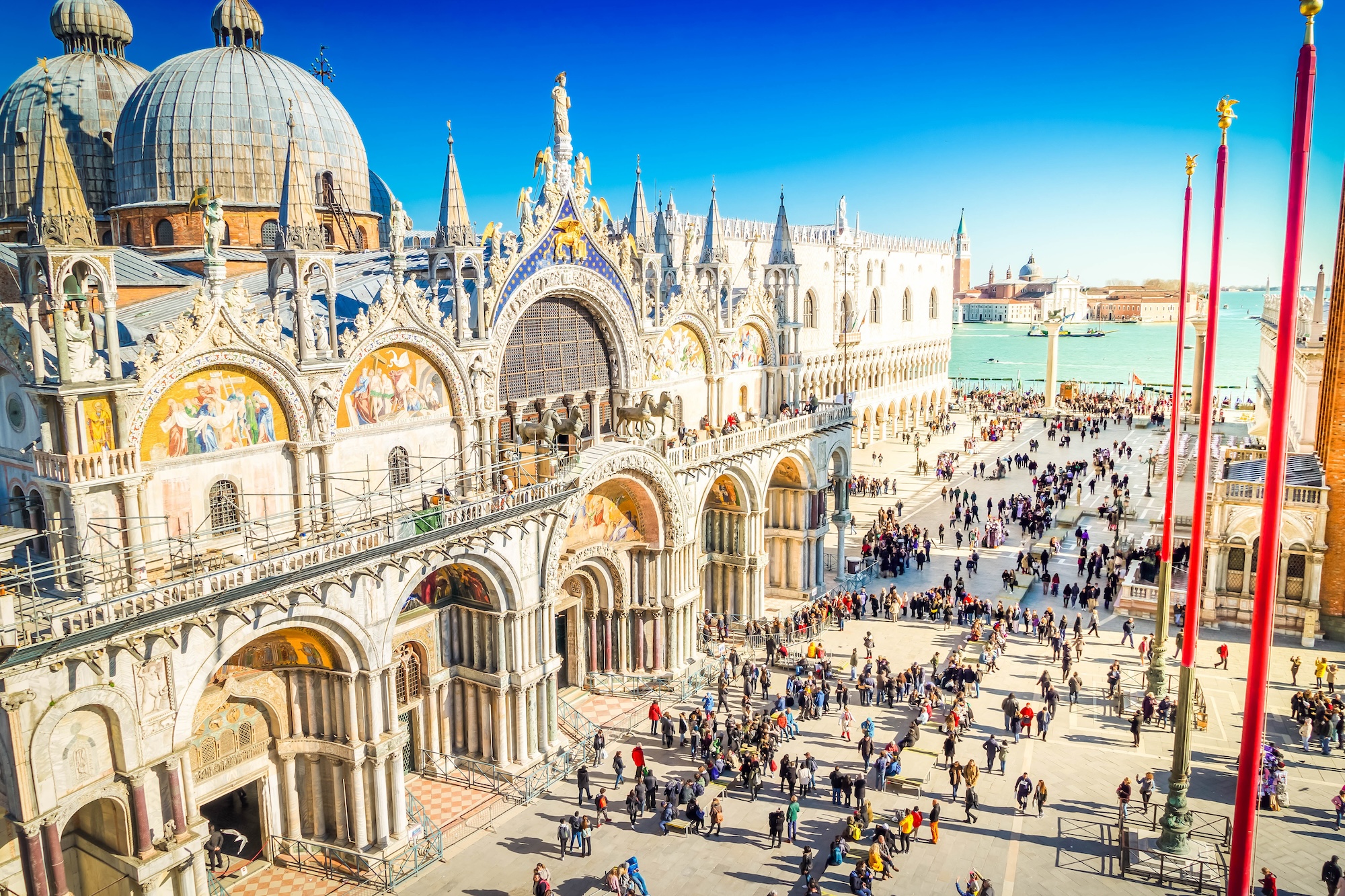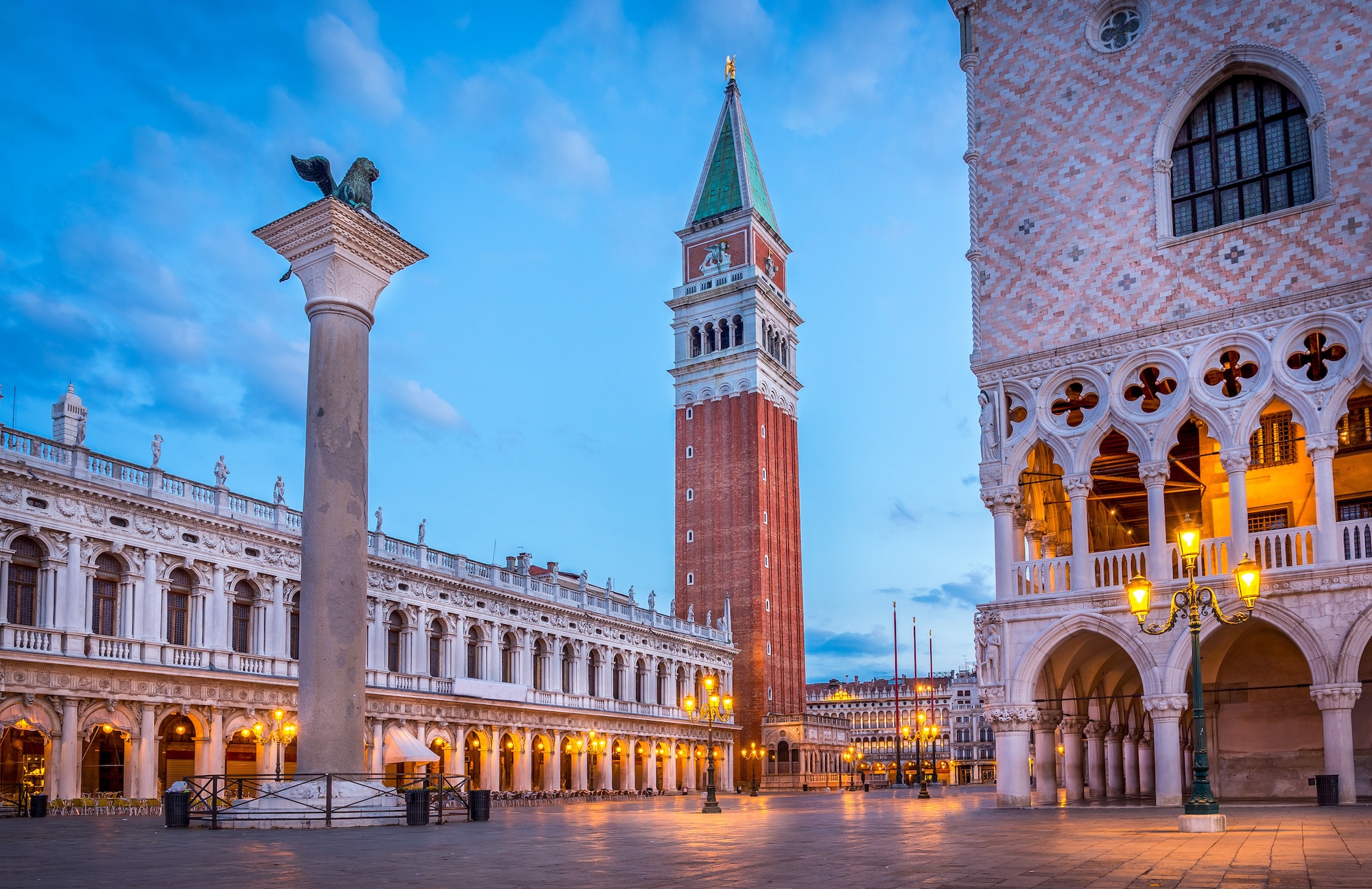
World Travel Tips
What Should You Do in Venice?
Venice is a city unlike any other, renowned for its winding canals, historic architecture, and romantic ambiance. With centuries of art, culture, and maritime history, Venice captivates visitors at every turn. Here are the top 10 attractions every traveler should experience in the “Floating City.”
1. St. Mark’s Basilica (Basilica di San Marco)

The crown jewel of Venetian architecture, St. Mark’s Basilica dazzles with its golden mosaics, intricate domes, and ornate façade. Located on the bustling Piazza San Marco, this cathedral reflects Venice’s long-standing ties with Byzantium and its wealth as a former maritime power.
Why visit?
St. Mark’s Basilica is a masterpiece of religious art and architecture. Its shimmering interiors, historical relics, and panoramic terrace views make it a must for any first-time visitor.
2. St. Mark’s Square (Piazza San Marco)

Often called “the drawing room of Europe,” St. Mark’s Square is Venice’s main public square, surrounded by historic buildings, cafés, and landmarks. The atmosphere here is lively day and night, with street musicians and classic Venetian charm.
Why visit?
St. Mark’s Square is the beating heart of Venice. It’s perfect for people-watching, enjoying a coffee, or simply soaking in the grandeur of the city’s most famous open space.
3. Rialto Bridge (Ponte di Rialto)

The oldest of Venice’s four Grand Canal bridges, Rialto Bridge is an icon of the city. Its distinctive stone arch and bustling market area have been central to Venetian life for centuries.
Why visit?
Rialto Bridge offers stunning views of the Grand Canal and easy access to local markets, shops, and traditional Venetian eateries.
4. Doge’s Palace (Palazzo Ducale)
A symbol of Venice’s political and artistic heritage, Doge’s Palace was the seat of the Venetian government for centuries. Its Gothic architecture, grand chambers, and impressive art collections tell the story of Venice’s power and intrigue.
Why visit?
Doge’s Palace is an architectural wonder and museum. Don’t miss the famous Bridge of Sighs, which connects the palace to the historic prison.
5. The Grand Canal
Venice’s main waterway, The Grand Canal, is lined with palaces, churches, and historic buildings. A ride along this iconic S-shaped canal—whether by vaporetto (water bus) or gondola—reveals the city’s most breathtaking views.
Why visit?
The Grand Canal is the ultimate Venetian experience. It’s the best way to see the city’s stunning facades and to get a true sense of life on the water.
6. Murano Island
Famed worldwide for its centuries-old glassmaking tradition, Murano Island is a short boat ride from Venice. Visitors can watch skilled artisans craft everything from delicate ornaments to vibrant glass sculptures.
Why visit?
Murano Island offers a glimpse into Venetian craftsmanship. The glass museums and studios are fascinating, and it’s the perfect spot for finding a one-of-a-kind souvenir.
7. Burano Island
Known for its vividly colored houses and lace-making heritage, Burano Island is one of Venice’s most photogenic spots. Its canals and bridges are quieter than those in the city center, making it a tranquil retreat.
Why visit?
Burano Island delights with its cheerful scenery and artisan shops. It’s a favorite for photographers and anyone looking to escape the city crowds.
8. Gallerie dell’Accademia
This world-class art museum, Gallerie dell’Accademia, holds the most important collection of Venetian paintings from the 14th to 18th centuries. Masterpieces by Bellini, Tintoretto, Veronese, and others fill its grand halls.
Why visit?
Gallerie dell’Accademia is essential for art lovers. The collection provides an unparalleled journey through Venice’s artistic legacy.
9. Teatro La Fenice
One of the world’s most prestigious opera houses, Teatro La Fenice has hosted premieres by composers like Verdi and Rossini. The opulent interiors and stellar acoustics make for an unforgettable night out.
Why visit?
Teatro La Fenice is a must for music and culture fans. Even a daytime tour reveals the glamour and drama of Venetian theater.
10. Peggy Guggenheim Collection
Housed in a former palazzo on the Grand Canal, the Peggy Guggenheim Collection showcases one of Europe’s finest collections of modern art. Works by Picasso, Pollock, Dalí, and more line its elegant rooms and sculpture garden.
Why visit?
The Peggy Guggenheim Collection offers a unique contrast to Venice’s Renaissance art, spotlighting 20th-century masterpieces in a stunning waterside setting.
Seasonal Recommendations
☀️ Summer (June–August): Summer is Venice’s peak season, with lively streets, outdoor events, and bustling canals. Temperatures average between 75°F to 85°F (24°C to 29°C), and long daylight hours are perfect for exploring landmarks like the Rialto Bridge or enjoying a gondola ride along the Grand Canal. Expect large crowds at popular attractions and higher hotel prices. The atmosphere is vibrant and festive, especially during open-air concerts and the famous Festa del Redentore in July.
🌸 Spring (March–May): Spring brings mild weather, blooming gardens, and fewer tourists. With temperatures ranging from 50°F to 70°F (10°C to 21°C), Venice feels fresh and inviting. It’s an ideal time for wandering quiet alleys, enjoying the colors of Burano Island, or visiting the Gallerie dell’Accademia without long lines. The city’s squares and cafés come alive as Venetians welcome the return of warm sunshine, making spring a favorite for those seeking a relaxed yet authentic experience.
🍁 Autumn (September–November): Autumn is a wonderful time for seasoned travelers, thanks to fewer crowds, comfortable weather, and stunning sunsets over the lagoon. Temperatures usually range from 55°F to 70°F (13°C to 21°C). The city takes on a romantic, golden glow, perfect for strolling around St. Mark’s Square or taking a peaceful vaporetto ride. Art lovers can also enjoy the Peggy Guggenheim Collection and other museums with ease. The annual Venice International Film Festival in early September adds extra excitement.
❄️ Winter (December–February): Winter in Venice is quiet, mystical, and enchanting, with temperatures from 35°F to 50°F (2°C to 10°C). Morning fog often shrouds the canals, creating a dreamy, almost surreal atmosphere. This is the best time to explore iconic spots like St. Mark’s Basilica or the Doge’s Palace without the crowds. February brings the world-famous Venice Carnival, with elaborate masks and festive parades. While it’s chillier, the peaceful streets and magical ambiance make winter a special season to experience the city’s true soul.
Venice Excursions
Tips for Your Visit
Getting Around
- Travel by Vaporetto: Venice’s public water buses (vaporetti) are the main way to get around the canals—buy a travel pass for unlimited rides.
- Walk the City: Venice is best explored on foot. Wander the narrow alleys and discover charming squares and hidden gems.
- Mind the Bridges: Be prepared for lots of bridges and steps; comfortable shoes are a must for navigating the city.
Local Cuisine
- Try Cicchetti: Sample Venice’s version of tapas—small bites served at local bars, often with a glass of local wine or spritz.
- Savor Seafood: Fresh seafood is a staple. Look for dishes like risotto al nero di seppia (squid ink risotto) and sarde in saor (sweet-and-sour sardines).
- Enjoy Gelato: Treat yourself to artisanal gelato from a local gelateria while strolling the canals.
Language
- Italian is Spoken: Italian is the main language, but many Venetians in tourist areas speak some English.
- Learn Basic Phrases: Knowing a few Italian greetings and polite phrases will be appreciated—try “buongiorno” (good morning) and “grazie” (thank you).
Safety
- Watch Your Belongings: Pickpocketing can occur in crowded places like St. Mark’s Square and on vaporetti—keep bags zipped and valuables secure.
- Plan for High Water: During autumn and winter, Venice can flood (acqua alta)—check forecasts and bring waterproof shoes if visiting then.
- Emergency Numbers: For emergencies, dial 112 for police, medical help, or fire services in Italy.
These tips will help you navigate Venice’s unique streets and canals, sample authentic cuisine, and enjoy a safe and memorable visit!
3 Popular Restaurants
The restaurant scene in Venice, Italy, offers a blend of old-world charm and contemporary flair, ranging from elegant fine dining to cozy bacari serving traditional cicchetti. Whether you’re seeking a romantic canal-side meal, creative takes on Venetian classics, or a lively local atmosphere, Venice’s diverse dining options are sure to delight every palate.
1. Osteria alle Testiere
Location: Calle del Mondo Novo, 5801, 30122 Venezia VE, Italy View On Map
Cuisine: Venetian Seafood (Fine Dining)
Why It’s Popular: With just a handful of tables, Osteria alle Testiere is an intimate gem beloved for its focus on the freshest local seafood and daily-changing menus. The chef’s refined yet authentic approach to Venetian classics like razor clams, lagoon shrimp, and spaghetti alle vongole has earned this spot a loyal following and rave reviews. Reservations are essential, as it’s often booked out well in advance.
2. Antiche Carampane
Location: Rio Terà de le Carampane, 1911, 30125 Venezia VE, Italy View On Map
Cuisine: Traditional Venetian (Seafood & Pasta)
Why It’s Popular: Tucked away from the busiest tourist paths, Antiche Carampane is cherished for its rustic charm and dedication to authentic Venetian cooking. Locals and visitors alike flock here for specialties such as fried soft-shell crab (moeche), tagliolini with spider crab, and warm, attentive service. The focus on local ingredients and old-school recipes makes it a favorite for those looking to experience true Venetian flavors.
3. Ristorante Quadri
Location: P.za San Marco, 123, 30124 Venezia VE, Italy View On Map
Cuisine: Contemporary Venetian (Michelin-Starred Fine Dining)
Why It’s Popular: Overlooking the iconic St. Mark’s Square, Ristorante Quadri is a Michelin-starred destination where tradition meets innovation. Chef Massimiliano Alajmo’s inventive tasting menus celebrate Venetian heritage with modern techniques and seasonal ingredients. The historic dining room, elegant service, and breathtaking views make it a memorable spot for a special occasion or a once-in-a-lifetime meal.
Tips for Dining in Venice
Venice, Italy is a city where every meal can feel like a celebration—whether you’re savoring fresh seafood beside a canal or sampling cicchetti in a lively bacaro. The Venetian dining scene is rooted in centuries of tradition, with influences from across the Mediterranean. Use these tips to make the most of every dining experience in the Floating City.
Important: Venice Tap Water is Safe to Drink
Venice’s tap water comes from deep artesian wells and is strictly monitored for safety. It’s perfectly safe to drink from the tap or from the many public fountains you’ll see around the city.
Tip: You can confidently drink tap water in Venice and refill your bottle at public fountains—no need to rely on bottled water. However, if you’re unsure about the pipes in an old building or see a “non potabile” sign, opt for bottled water just in case.
1. Make Reservations, Especially for Dinner
Venice’s most popular restaurants and trattorias fill up quickly, particularly in high season or in areas near St. Mark’s Square.
Tip: Reserve a table in advance—especially for dinner or weekends—using online platforms or by calling directly. Walk-ins are more common at casual spots and bacari, but even these can get crowded.
2. Embrace Venetian Specialties
Local cuisine centers on fresh seafood, risotto, and seasonal vegetables. Must-try dishes include sarde in saor (sweet and sour sardines), risotto al nero di seppia (squid ink risotto), and fegato alla veneziana (Venetian-style liver).
Tip: Ask your server for local recommendations or daily specials—Venetian cuisine shines when you try what’s in season and locally sourced.
3. Enjoy Cicchetti Culture
Cicchetti are small bites or snacks, typically enjoyed with an ombra (a small glass of wine) in a neighborhood bacaro (Venetian bar). These are perfect for a light lunch or an informal dinner.
Tip: Hop between different bacari in the early evening to sample a variety of cicchetti. Favorites include baccalà mantecato (creamed cod), polpette (meatballs), and fried seafood.
4. Mind the Cover Charge and Service Fees
Most restaurants add a “coperto” (cover charge) per person and sometimes a service fee, especially in tourist areas.
Tip: Check the menu or ask your server if you’re unsure about extra charges. Tipping is not obligatory, but it’s appreciated to round up or leave a small amount for good service.
5. Be Aware of Mealtimes
Venetians eat lunch from around 12:30–2:30 PM and dinner from 7:00–10:00 PM. Many restaurants close between lunch and dinner, especially outside tourist zones.
Tip: Plan your meals around local dining hours. For a snack between meals, visit a bakery or enjoy cicchetti at a bacaro.
6. Know Where to Eat Near Major Attractions
Cafés and restaurants around St. Mark’s Square and the Rialto Bridge can be expensive and touristy.
Tip: For more authentic cuisine and better value, walk a few streets away from the main attractions or explore local neighborhoods like Cannaregio or Dorsoduro.
7. Don’t Miss Venetian Desserts
Venetian sweets are delightful, from fritole (Carnival doughnuts) to tiramisu, which was invented nearby.
Tip: Save room for dessert or stop at a gelateria for artisanal gelato as you stroll through the city’s charming streets.
8. Ordering Coffee Like a Local
Coffee culture in Venice is quick and straightforward—espresso at the bar is the norm, while sitting at a table can cost significantly more, especially in famous cafés.
Tip: If you’re after a quick caffeine fix, order “un caffè” and drink it standing at the bar for the local experience and a lower price.
9. Sample Local Wines and Spritz
Veneto is known for its wines, including Prosecco and Soave, and Venice is the birthplace of the classic spritz cocktail.
Tip: Try a glass of local wine with your meal or enjoy an Aperol or Select spritz at sunset, preferably at a canal-side bar.
10. Expect to Linger Over Meals
Dining in Venice, as in much of Italy, is a leisurely affair. Meals are meant to be savored and enjoyed in good company.
Tip: Don’t rush—embrace the slower pace, enjoy the ambiance, and use meals as a time to relax and connect with Venetian culture.
Conclusion
Dining in Venice is more than just eating—it’s about experiencing the city’s rich history, flavors, and traditions. With a little planning and an open mind, you’ll enjoy memorable meals, discover new favorites, and take home a true taste of Venice. Buon appetito!








